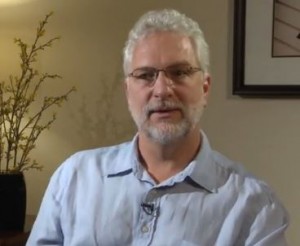After our holiday break, it’s time to get back to moving up the Bridge to Total Freedom! When we left off in December, Claire and Bruce had taken us all the way through Operating Thetan Level Three and L. Ron Hubbard’s epic handwritten tale about the galactic genocidal warlord, Xenu. This week, it’s on to OT 4, but initially we’re going to look at “old” OT 4, which Claire tells us she didn’t experience.
BRUCE: like Claire I never did the old version of OT 4, nor did I study it. After the release of Dianetic Clear and NOTs in September, 1978, very few people did this older version of OT 4. And after about 1982, no one did it at all. In fact, these days, of the OT levels, only OT 2 and OT 3 are the same as their original versions.
THE BUNKER: All right, so we’ll look at it purely for the historical value. Looking through the course materials, there seem to be a lot of warnings about preparation and review, which by this time we’re very familiar with.
The new question that is apparently of utmost importance this time is to ask the subject, “What valence would be safe?”
BRUCE: The process was called a valence shifter by Hubbard. It is a repetitive process, meaning that the same question is asked over and over again until the “end phenomena” occur. There is quite a lot of theory behind it. First is the Scientology definition of a “valence.” This is, roughly, an identity or beingness that the person, as a spirit, has assumed. As a person goes through life, and as they went through their many, many previous lifetimes, they take on, usually unknowingly, different valences. This is an idea from early Dianetics. A simple example would be a young boy who has an experience that forms an engram (a mental picture containing pain and unconsciousness) of being beaten by his father. Later in life when this engram, and probably other related things in the reactive mind, get restimulated, the now grown-up boy might go into the valence of his father, without realizing it. He might say things that his father said, or have his father’s mannerisms, or act out on other people the way his father did. In those times, the person is not being himself or is “out of valence.” The father would be the “winning valence.” At the time of the incident, it was unsafe for the boy to be himself. It would be safe to be the father, since the father was not being beaten. Aberrated people are not being themselves. The power of the being can only be realized when they are being themselves. In auditing, one must be in their own valence in order to erase an incident; that is, they have to view the incident from the same viewpoint that they had when the incident happened. As a person moves up the bridge, they supposedly shed many, many false valences and become more and more themselves.
So, in the older version of OT 4, the person receives this process from another auditor; it is not run solo. It was considered to be a very powerful process. Answers to the question could be, possibly, “that drill sergeant,” “a Roman centurion,” “that implanter in the Helatrobos Implants,” or whatever. These false valences would be stripped away and eventually the person being audited should have a realization along the lines of “I’m just myself.”
THE BUNKER: We are us. Got it.
Speaking of an “end phenomenon,” for OT 4, that “EP” is “Certainty of self as a being.” Hey, that sounds like something worth paying thousands to obtain!
And we’re told that the point here is to “proof up a being against any possibility of being reimplanted in the future.”
We take that to refer to between-lives implanting. The idea is to prevent your memory from being erased on an implant station on Mars or Venus before you take on a new body?
BRUCE: In theory, if a being is just himself, or herself, and then confront whatever happens to them, even someone attempting to implant them, the experience can have no lasting negative effect on them. A future implant could be a “between-lives implant,” or it might happen in some future, oppressive society. Think 1984 or A Clockwork Orange.
THE BUNKER: Yeah, but if you get us thinking about Orwell or Burgess, the mere thought of L. Ron Hubbard’s writing is going to make our head explode.
Anyway, back to OT 4.
It turns out that the meat of this level is a series of interesting exercises, and we’re going to paraphrase them. Yes, we said paraphrase for any lawyers taking notes…
The steps of OT 4:
1. Mock up and unmock one of the “GPMs” — incidents in our whole tracks. We read this to mean that you’re going to concentrate hard enough to sort of create and break down your own implants from the trillion-year distant past.
2. Now you’re going to practice heating up your own body with your mind.
3. Create and uncreate your own reactive mind — which you had supposedly gotten rid of when you went “clear.”
4. Create and uncreate a “non-atomic light.”
5. “Move the body and notice who is doing it. Run to a cognition.”
6. Audit disagreements and problems that have to do with the physical universe.
7. More of the same.
8. More self-interrogation of past misdeeds.
9. Add up all of your auditing hours.
10. “Run your favorite havingness process.”
11. Go sit on a park bench or in a shopping mall and spot things. Such as… Time, an animal, “another’s universe,” etc.
And then attest to OT 4!
Hey, that sounds easy as pie.
BRUCE: The steps 1 through 9 were done as a solo auditor. To mock something up is to create a mental image of it. For example, if one imagines a red pyramid with mauve stripes, that is a mock-up. This is a key concept in attaining and keeping the State of Clear. A person’s reactive mind, or “bank,” is composed of mental pictures of zillions of traumatic experiences. Since most of these experience supposedly happened way before one’s body existed, it is believed that these pictures are not stored in the brain. The thetan himself carries these pictures around with him for eons and eons. When one goes Clear, they supposedly realize that they themselves have been creating their own reactive mind. Or to put it another way, they were mocking up their own bank. They had been doing this in some automatic, unconscious way for all those zillions of years. And when they go Clear, they don’t have to keep doing this anymore.
So the first steps have to do with practicing mocking up things, and presumably noticing that there is no liability in it when it is done on a knowing basis. A person who was really OT would be able to make mock-ups that others could see.
I don’t know what he means by “non-atomic light.”
Some of the other steps are very generally worded and might be done in many different ways. I guess they are supposed to get the thetan to view things that make him hold himself back, bring him to realize that he is a being distinct from other things and other beings, and to get him into present time.
An example of a havingness process, usually done by an auditor on another person, is “Look around here and tell me what you could have.” This is also done repetitively, usually for 10 or 12 commands.
To some degree I’m guessing, as I had no person experience with this level.
THE BUNKER: Well, Bruce, we appreciate you giving it your best shot. After OT 3, this material from Old OT 4 does seem like a letdown. But next week, we’ll look into what replaced it! (And then total up our new costs. Our current tally is $278,273.25.)
——————–
Posted by Tony Ortega on January 14, 2014 at 07:00
E-mail your tips and story ideas to tonyo94@gmail.com or follow us on Twitter. We post behind-the-scenes updates at our Facebook author page. Here at the Bunker we try to have a post up every morning at 7 AM Eastern (Noon GMT), and on some days we post an afternoon story at around 2 PM. After every new story we send out an alert to our e-mail list and our FB page.







